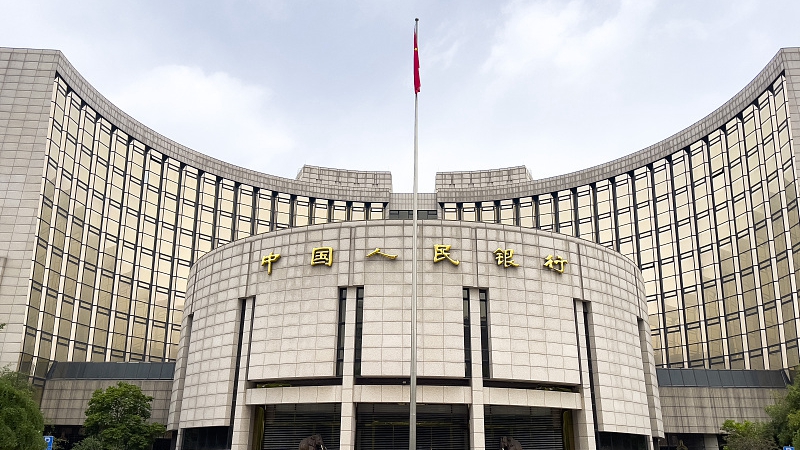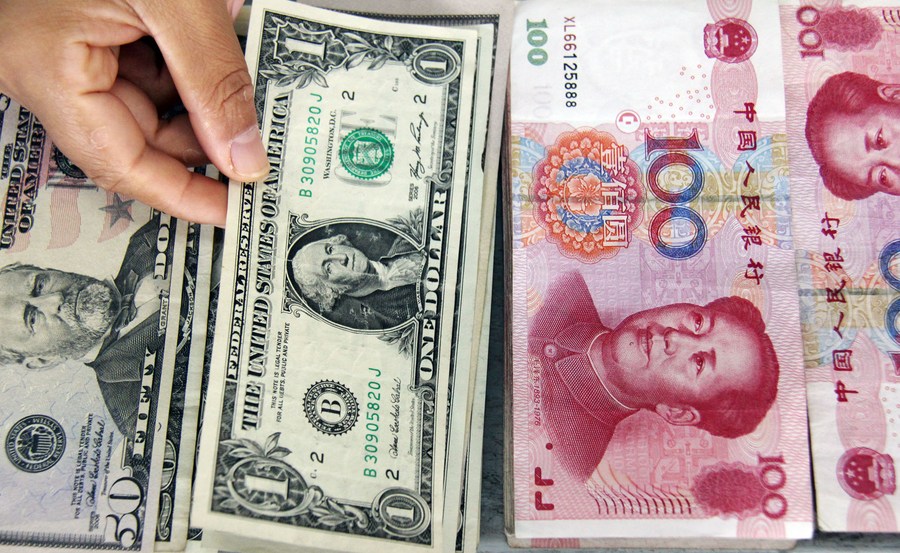
The headquarters of the People's Bank of China in Beijing, capital of China, June 1, 2023. /Xinhua
The headquarters of the People's Bank of China in Beijing, capital of China, June 1, 2023. /Xinhua
Editor's note: Liu Chunsheng, a special commentator for CGTN, is an associate professor at the Beijing-based Central University of Finance and Economics. The article reflects the author's opinion, and not necessarily the views of CGTN.
The People's Bank of China (PBOC) announced that starting from September 15, 2023, the reserve requirement ratio for financial institutions on foreign exchange deposits would be reduced by 2 percentage points. Specifically, the reserve requirement ratio for foreign exchange deposits would be lowered from the current 6 percent to 4 percent.
The reduction in the reserve requirement ratio for financial institutions' foreign exchange deposits will enhance the capacity of banks and other financial institutions to utilize foreign exchange funds. It will also directly increase onshore U.S. dollar liquidity, alleviating pressure on the depreciation of the Renminbi (RMB) exchange rate.
The depreciation of the RMB has always been one of the focal points of attention both domestically and internationally. RMB depreciation has sparked widespread debate and speculation because it not only impacts China's domestic economy, but also would have profound consequences on the global economic landscape.
The depreciation of the RMB results from a complex array of factors. China's economic growth has gradually decelerated, leading to concerns among certain investors about the Chinese economy. China's economic data for the first two quarters of the year 2023 fell short of expectations. Especially in the second quarter, GDP growth was 6.3 percent, which was below market expectations, given the low base effect caused by the pandemic in the previous year. Particularly, the sluggish export data influenced confidence in the RMB.
Consequently, this reduced demand for the RMB and contributed to its depreciation. The trade dispute between China and the United States has triggered tariff escalations and trade uncertainties, adversely affecting the RMB's exchange rate. The Federal Reserve's continuous pace of interest rate hikes has exceeded market expectations.
The Chinese government has implemented various monetary policies to stimulate economic growth, including lowering interest rates and increasing credit supply. These policies may lead to the reduction of the purchasing power of the RMB and causing depreciation.
On the other hand, due to the continuous interest rate hikes by the U.S. dollar, the U.S. dollar index has risen, leading to the depreciation of the RMB against the U.S. dollar. Moreover, the volatility and uncertainty in international financial markets can drive investors to seek safe-haven assets, impacting the RMB's exchange rate.

File photo shows a teller picks a dollar bill among banknotes of U.S. dollar and Renminbi (RMB) at a bank in Linyi, east China's Shandong Province. /Xinhua
File photo shows a teller picks a dollar bill among banknotes of U.S. dollar and Renminbi (RMB) at a bank in Linyi, east China's Shandong Province. /Xinhua
The long-term unilateral depreciation of the RMB will trigger a devaluation of domestic assets, leading to weakness in sectors such as finance and real estate, which in turn will drag down the overall economic performance. On the other hand, once the expectation of RMB depreciation takes hold, it will lead to the outflow of hot money, causing a rapid tightening of the liquidity environment in the A-share market.
Therefore, a stable RMB exchange rate contributes to the stability of China's foreign trade. China is one of the world's largest exporters, and a stable currency provides predictability, making it easier for exporters to plan and price their products, thus enhancing their competitiveness in international trade.
There are also merits for a stable currency value. It typically makes a country more attractive for foreign direct investment (FDI). Foreign investors are more inclined to invest in a country with a relatively stable exchange rate because it reduces their currency risk. A stable currency value helps control inflation. If the currency value experiences sharp fluctuations, it can lead to price fluctuations for imported goods, increasing inflation risks. A stable currency value aids in maintaining price stability.
A stable currency value helps build trust with international trade partners. Other countries are more willing to engage in trade with a country whose currency value is stable, as it reduces transaction risk. A stable currency value contributes to maintaining stability in domestic financial markets.
The reduction in the reserve requirement ratio for financial institutions' foreign exchange deposits sends a clear policy signal from the PBOC regarding its efforts to stabilize the foreign exchange market. This move explicitly signals the intention to stabilize the foreign exchange market's expectations and maintain the RMB exchange rate at a reasonably balanced level. It can, to a certain extent, curb expectations of unilateral RMB depreciation and prevent phenomena like "one-way markets" and "herd behavior."
(If you want to contribute and have specific expertise, please contact us at opinions@cgtn.com. Follow @thouse_opinions on Twitter to discover the latest commentaries in the CGTN Opinion Section.)